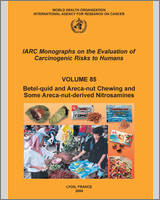NCBI Bookshelf. A service of the National Library of Medicine, National Institutes of Health.
IARC Working Group on the Evaluation of Carcinogenic Risks to Humans. Betel-quid and Areca-nut Chewing and Some Areca-nut-derived Nitrosamines. Lyon (FR): International Agency for Research on Cancer; 2004. (IARC Monographs on the Evaluation of Carcinogenic Risks to Humans, No. 85.)

- Lichenoid lesions
clinically resemble idiopathic oral lichen planus but represent type IV contact hypersensitivity reactions. In areca-nut chewers, they are found at the site of quid placement and are unilateral in nature.
- Betel chewer's mucosa (BCM)
brownish-red discoloration of the oral mucosa, often accompanied by encrustation with quid particles, which are not easily removed, and show a tendency for desquamation and peeling. The underlying area of the mucosa assumes a wrinkled appearance. The lesion is usually localized and associated with the site of quid placement in the buccal cavity (Figure 6).
- Erythroplakia
a bright red lesion of the oral mucosa that cannot be characterized clinically or pathologically as any other definable lesion (Axéll et al., 1984; WHO, 1996).
- Oral leukoplakia
predominantly white patch or plaque on the oral mucosa that cannot be characterized clinically or pathologically as any other disease and is not associated with any physical or chemical causative agent except tobacco (Axéll et al., 1984). Based on clinical appearance, leukoplakia can be divided into two main subtypes: homogeneous leukoplakia (white) and non-homogeneous — including speckled or nodular — leukoplakia (red/white) (Figure 7).
- Oral lichen planus
a chronic inflammatory disease of the skin and the oral mucosa of unknown etiology, although alterations in cell-mediated immunity may be important. Clinically, six types of oral lichen planus are described: papular, reticular, plaque-like, atrophic, erosive (ulcerative) and bullous. Malignant transformation has been observed in up to 2–3% of patients.
- Oral submucous fibrosis (OSF)
chronic disorder characterized by fibrosis of the lining mucosa of the upper digestive tract involving the oral cavity, oro- and hypopharynx and the upper third of the oesophagus (Johnson et al., 1997). The fibrosis involves the lamina propria and the submucosa and may often extend into the underlying musculature, resulting in the deposition of dense fibrous bands. These bands give rise to the limited mouth opening, which is a hallmark of this disorder (Figure 8).
- Precancerous conditions
a generalized state associated with a significantly increased risk for cancer (WHO, 1996).
- Precancerous lesions
a morphologically altered tissue in which cancer is more likely to occur than in its apparently normal counterpart (WHO, 1996).
- GLOSSARY B — PRECANCEROUS LESIONS AND CONDITIONS AND SOME OTHER BETEL QUID-ASSOC...GLOSSARY B — PRECANCEROUS LESIONS AND CONDITIONS AND SOME OTHER BETEL QUID-ASSOCIATED LESIONS - Betel-quid and Areca-nut Chewing and Some Areca-nut-derived Nitrosamines
Your browsing activity is empty.
Activity recording is turned off.
See more...